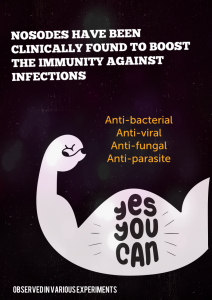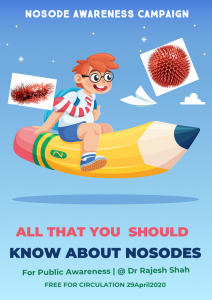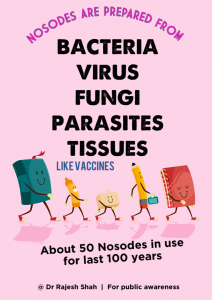COVID19 pandemic does not have any proven prevention or cure as of 20th April 2020. Every logical and evidence-based lead must be explored as an opportunity without bias. Homeopathy has offered some positive leads based on evidence found in laboratory models, animal models, human trials and clinical experience of the last two centuries.
In fact, homeopathy became popular due in Europe due to its success in treating epidemic diseases such as cholera, yellow fever, and typhus.[i]
Despite the limitation of data in terms of quantity and quality, some of the evidence have been encouraging to explore more of homeopathy in the current COVID19 pandemic. More compelling studies would have certainly helped. I personally feel that this is the time to create more compelling evidence for now and the future, rather than undermining the importance of what is available.
The system of homeopathy based on the natural phenomenon called the law of similars, having over 1500 medicines used on the basis of their ability to produce disease like symptoms in toxic form, and treat similar diseases when used in very low ‘potentized’ dose, to the tune of nano-particles. One may like to compare it with the phenomenon ‘hormesis’ in biology as well with the principle behind vaccines, where disease-causing germs are ‘attenuated’ and administered for preventing infections.
- Antimicrobial efficacy in epidemics, pandemics
- Spanish flu: There is anecdotal evidence that homeopathy was successful during the Spanish flu epidemic of 1918 to 1919, in which at least 20 million people died worldwide, more than 500,000 in the United States alone. According to the historian Julian Winston, the death rates for patients treated with homeopathy (Gelsemium) were 1 to 2% compared with a 30 to 60% mortality for those treated by conventional physicians.1
- Chikungunya: A cluster, randomized, double-blind placebo-controlled trial using Bryonia alba to prevent Chikungunya had shown 20% less prevalence in the homeopathy treated patients.[ii]
- Chemical injury to Mustard gas: In London and Glasgow during World War II, using potentized mustard gas as a preventative for chemical injury from mustard gas. The results of this experiment demonstrated a statistically significant decrease in deep skin lesions in those given Mustard gas 30c prior to applying mustard gas to their skin compared to those receiving placebo.[iii]
- Influenza: In the Influenza epidemic in 1918 in Dayton, Ohio, USA, homeopathically treated 26000 patients had a mortality rate of 1.05% as compared to the conventionally treated 24000 cases having 28% mortality.
- Influenza: Oscillococcinum has shown some results in a double-blind study in France to treat patients with influenza-like illness.
- Influenza and acute respiratory infections: In a blind, randomized, placebo-controlled clinical trial conducted in Brazil, the results suggested that the use of homeopathic nosode based medicines minimized the number of flu and acute respiratory infection symptomatic episodes in children, indicating homeopathic prophylactic potential.
- Leptospirosis: During an epidemic of leptospirosis in Cuba in 2007-2008,
97% of the entire population over one year of age was treated with a nosode that comprised four strains of inactivated leptospira. There was an 84% decrease in incidence as compared to the untreated group.
- Dengue
- In Brazil, in May 2001, a single dose of the homeopathic remedy Eupatorium perfoliatum 30C was given to 40% of residents of the most highly affected neighborhood. Thereafter, dengue incidence decreased by 81.5%, a highly significant decrease as compared with neighborhoods that did not receive homeopathic prophylaxis.
- Again in early 2007, 156,000 doses of homeopathic remedy were freely distributed in April and May 2007 to asymptomatic population, according to the notion of “epidemic genus.” The remedies used were homeopathic complex against dengue containing Phosphorus 30cH, Crotalus horridus 30cH and Eupatorium perfoliatum 30cH. The incidence of the disease in the first 3 months of 2008 fell by 93% in comparison to the corresponding period in 2007, whereas in the rest of the state of Rio de Janeiro there was an increase of 128%.
- CCRH (Central Council for Research in Homeopathy, Ministry of Health, India) had undertaken clinical trials in Dengue and Acute Encephalitis syndrome/JE with Homeopathy as an add-on to usual care in tertian care setups. In Dengue Hemorrhagic fever, add on Homeopathy could bring early improvement in platelet count and decrease in hospital stay by 2 days. Similarly, in Acute Encephalitis Syndrome/Japanese Encephalitis homeopathy as an adjuvant to the Institutional Management protocol could decrease the death rate by 15% in comparison to those who received only Institutional Management protocol.
In Cuba, 25,000 patients who tested positive for dengue were treated with a homeopathic complex containing medicines Bryonia alba, Eupatorium perfoliatum, Gelsemium sempervirens, and Dengue nosode. As a result, no severe symptoms were reported after its administration, nor did any patient require any more intensive care from an average of 3 to 5 days of entering an Intensive Care Unit. Even the stay at the hospital reduced from 7–10 days to 3–5 days.
Antimicrobial efficacy in Animal model:
1. Japanese Encephalitis
Experiments utilizing two different models- CAM model and suckling mice model, both conclusively indicated that this medicine has got a definite role in preventing Japanese Encephalitis.
- Trypanosoma cruzi parasites
A significantly shorter period of patent parasitemia was observed in the mice group treated with the specific nosode before infection than in the other groups. This group also had the lowest parasitemias values at 9, 13, 15 (p < 0.05), 17 (p < 0.05), 22, 24 and 28 days, a lower rate of mortality and a significant increase of lymphocytes compared to the infected control group.
- Leishmaniasis
The prevalence of Th1/Th2 response, spleen changes and megakaryocytes were investigated in BALB/c mice (n = 138) infected with Leishmania infantum, and treated with Leishmania infantum 30_ (10_30), a nosode. Pre/post and post-treatment presented a reduction of megakaryocytes/spleen changes due to immunomodulation animal process, controlling the infection process, probably by the Th1 cytokine predominance.
4. Malaria
Antimalarial potential of Nosode 30 and 200 against Plasmodium berghei infection in BALB/c mice was observed in the mice model. Homeopathic nosodes exhibited 87.02 and 37.97% chemosuppression on Day 7 and mean survival time (MST) of 18.5 ± 2.16 and 16.5 ± 1.37 days respectively, which were statistically significant when compared to MST of infected control (8.55 ± 0.83 days). [
- Influenza
In an animal study on Influenza conducted by Brazilian scientists, Flow cytometry and morphometry revealed significant changes in T and B cell balance after influenza antigen challenge, varying according to treatment. The results show that homeopathic treatments with Influenzinum nosode and Thymulin induced subtle changes in acquired immune anti-viral response regulation.
- H. pylori
- pylori nosode was able to initiate the infection resistive forces in the animals before being subjected to the infection of H. pylori, indicating a specific prophylactic role of the nosode.
Piglets of the homeopathic treated group had significantly less E. coli diarrhea than piglets in the placebo group (P<.0001), with E coli nosode.
 III. Antimicrobial efficacy in the laboratory model
III. Antimicrobial efficacy in the laboratory model
1. Influenza
An in vitro study where the Influenza virus nosode-treated MDCK cells showed significant changes in 6-Phosphofructo-1-kinase activity. The effect of the nosode on TNF-a production by J774.G8 cells suggests a stimulatory effect on these cells, showing effects on the host cells, not on the virus particles or virus replication cycle.
2. Malaria
An in vitro study by the author and team has shown anti-malarial activity of Plasmodium falciparum nosode. The hemozoin content was determined by measuring the absorbance at 400 nm. The results were recorded as % inhibition of heme crystallization compared to a negative control (DMSO). The P. falciparum nosode exhibited inhibition of hemozoin suggestive a potential antimalarial activity.
- E. Coli, Salmonella Typhi, K. pneumoniae and Candida albicans
A series of studies (publications under review) by the author (and team) presents the results of minimum inhibitory concentration (MIC) assay results of new nosodes namely Candida albicans, Klebsiella pneumoniae, Escherichia coli, Salmonella typhi tested against respective and cross infections.
- Antiviral
In vitro study, the homeopathic preparation Gripp-Heel (containing Aconitum, Bryonia, Eupatorium), Lachesis and phosphorus) showed inhibitory activity against an exceptionally broad spectrum of virus strains, including enveloped as well as non-enveloped viruses of both DNA and RNA varieties.[xxii]
- Antimicrobial efficacy in a human model
- HIV infection
An observational study with thirty HIV infected patients were administered HIV Nosode in 30c potency over six months. The responder group had reduced viral load and increase in CD4 count.
- Hepatitis C
A similar observation study with Hepatitis C infected patients demonstrated a decrease in viral load in the responder group.
- Tuberculosis
Add on homeopathy in addition to standard therapy appears to improve outcome in a human trial in MDR-TB, shown in a study by CCRH, under the Ministry of AYUSH, Government of India. [xxv]
Enough evidence for exploration
Well, the proven evidence of homeopathy as anti-viral, anti-bacterial, anti-microbial in cell-lines, animals, and human models are enough clues for the exploration of common homeopathic anti-microbial medicines as well as the nosodes against Covid19 pandemic now, and in future.
[i] Jacobs J. Homeopathic Prevention and Management of Epidemic Diseases. Homeopathy. 2018; 107(3):157-160 https://www.ncbi.nlm.nih.gov/pubmed/29753299
[ii] Janardanan Nair K R, Gopinadhan S, Sreedhara Kurup T N, Kumar BJ, Aggarwal A, Varanasi R, Nayak D, Padmanabhan M, Oberai P, Singh H, Singh VP, Nayak C. Homoeopathic Genus Epidemicus ‘Bryonia alba’ as a prophylactic during an outbreak of Chikungunya in India: A cluster -randomised, double -blind, placebo- controlled trial. Indian J Res Homoeopathy 2014;8:160-5
[iii] Dean ME. The mustard gas experiments done by the British Homoeopathic Society for the Ministry of Home Security, 1941-1942. J R Soc Med. 2014;107(11):453–455. doi:10.1177/0141076814521937
https://www.ncbi.nlm.nih.gov/pmc/articles/PMC4224645/
[iv] The Journal of the American Institute for Homeopathy, May 1921, page 1038 https://www.ecampnd.com/homeopathy/A_Chorus_of_Fifty_in_Harmony.pdf
http://likecure.com/acatalog/Influenza_Epidemic__1918.html
[v] Ferley JP, Zmirou D, D’Adhemar D, Balducci F. A controlled evaluation of a homeopathic preparation in the treatment of influenza-like syndromes. Br J Clin Pharmacol. 1989;27(3):329–335. doi:10.1111/j.1365-2125. 1989.tb05373.x https://www.ncbi.nlm.nih.gov/pmc/articles/PMC1379831/
[vi] Siqueira CM, Homsani F, da Veiga VF, Lyrio C, Mattos H, Passos SR, Couceiro JN, Quaresma CH. Homeopathic medicines for the prevention of influenza and acute respiratory tract infections in children: a blind, randomized, placebo-controlled clinical trial. Homeopathy. 2016 Feb; 105(1): 71–77. Published online 2015 Aug 4. doi: 10.1016/j.homp.2015.02.006 https://www.ncbi.nlm.nih.gov/pubmed/26828000
[vii] Bracho G, Varela E, Fernández R, Ordaz B, Marzoa N, Menéndez J, et al. Large‑scale application of highly‑diluted bacteria for leptospirosis epidemic control. Homeopathy 2010;99:156‑66. https://www.ncbi.nlm.nih.gov/pubmed/20674839
[viii] Marino R. Homeopathy and Collective Health: The Case of Dengue Epidemics. Int J High Dilution Res 2008;7:179-85. https://www.researchgate.net/publication/282446020_Dengue_epidemic_What_can_we_offer
[ix] Nunes L. Reynaldo AS. Amorim MHC. Zandonade E. Salume S. Contribution of homeopathy to the control of an outbreak of dengue in Macaé, Rio de Janeiro. Int J High Dilution Res 2008;7:186-92. https://www.researchgate.net/publication/282446020_Dengue_epidemic_What_can_we_offer
[x] Nayak D, Chadha V, Jain S, Nim P, Sachdeva J, Sachdeva G et al. Effect of Adjuvant Homeopathy with Usual Care in Management of Thrombocytopenia Due to Dengue: A Comparative Cohort Study. Homeopathy. 2019 Aug; 108(3):150-157. doi: 10.1055/s-0038-1676953. https://www.ccrhindia.nic.in/showimg.aspx?ID=15677
[xi] Oberai P, Varanasi R, Padmanabhan M, Upadhyaya A, Singh S, Singh SP. Effectiveness of Homeopathic Medicines as Addon to Institutional Management Protocol for Acute Encephalitis Syndrome in Children https://www.ccrhindia.nic.in/showimg.aspx?ID=15677
[xii] Bracho G. Homoeopathy and ultradilutions: From basic evidences to practical applications. Power point presented at 14th Japanese Homoeopathic Medical Association (JPHMA) Congress. 7-8 December 2013. https://www.researchgate.net/publication/282446020_Dengue_epidemic_What_can_we_offer
[xiii] Bhaswati Bandyopadhyay et al.The Role of ‘Belladonna 200’ in the Prevention of Japanese Encephalitis (JE) Virus Infection. School of Tropical Medicine, Kolkata India
[xiv] Almeida LR, Campos MC, Herrera HM, Bonamin LV, da Fonseca AH. Effects of homeopathy in mice experimentally infected with Trypanosoma cruzi. https://www.ncbi.nlm.nih.gov/pubmed/18439966
[xv] Cajueiro APB, Goma EP, Dos Santos HAM, Almeida Rodrigues, Toma HK, Araújo SM, Bonamin LV, Gomes NBN, Castelo-Branco MTL, de Souza Dias EP, Dos Santos Pyrrho A, Holandino C. Homeopathic medicines cause Th1 predominance and induce spleen and megakaryocytes changes in BALB/c mice infected with Leishmania infantum. Cytokine. 2017 Jul;95:97-101. doi: 10.1016/j.cyto.2017.02.010. Epub 2017 Feb 27. https://www.ncbi.nlm.nih.gov/pubmed/28254560
[xvi] Bagai U1, Rajan A, Kaur S. Antimalarial potential of Nosode 30 and 200 against Plasmodium berghei infection in BALB/c mice. J Vector Borne Dis. 2012 Jun;49(2):72-7. https://www.ncbi.nlm.nih.gov/pubmed/22898477
[xvii] Siqueira CM, Motta PD, Cardoso TN, de Paula Coelho C, Popi AF, Couceiro JN, Bonamin LV, Holandino C. Homeopathic treatments modify inflammation but not behavioral response to influenza antigen challenge in BALB/c mice. Homeopathy. 2016 Aug;105(3):257-264. doi: 10.1016/j.homp.2016.04.002. Epub 2016 May 4. https://www.ncbi.nlm.nih.gov/pubmed/27473547
[xviii] Gosavia TP. Ghosh P. Kandhare AD. Kumar S. Subhash RR. Bodhankar L. Therapeutic effect of H. pylori nosode, a homeopathic preparation in healing of chronic H. pylori infected ulcers in laboratory animals. Asian Pacific Journal of Tropical Disease, 2012. Volume 2, Supplement 2, 2012, Pages S603-S611. https://www.academia.edu/41406948/Therapeutic_effect_of_H._pylori_nosode_a_homeopathic_preparation_in_healing_of_chronic_H._pylori_infected_ulcers_in_laboratory_animals
[xix] I Camerlink, L Ellinger, EJ Bakker and EA Lantinga Homeopathy as replacement to antibiotics in the case of Escherichia coli diarrhoea in neonatal piglets Homeopathy. 2010 doi:10.1016/j.homp.2009.10.003, https://www.ncbi.nlm.nih.gov/pubmed/20129177
[xx] Siqueira CM, Costa B, Amorim AM, Gonçalves M, Féo da Veiga V, Castelo-Branco M, Takyia C, Zancan P, Câmara FP, Couceiro JN, Holandino C. H3N2 homeopathic influenza virus solution modifies cellular and biochemical aspects of MDCK and J774G8 cell lines. Homeopathy. 2013 Jan;102(1):31-40. doi: 10.1016/j.homp.2012.10.003.https://www.ncbi.nlm.nih.gov/pubmed/23290877
[xxi] Joshi S. Munshi R. Talele G. Shah R. An experimental in vitro study to evaluate the antimalarial activity of select homeopathy preparations. International Journal of Medical and Health Research. Volume 3; Issue 7; July 2017; Page No. 65-68. http://www.medicalsciencejournal.com/archives/2017/vol3/issue7/3-7-19
[xxii] Glatthaar-Saalmüller B. In vitro evaluation of the antiviral effects of the homeopathic preparation Gripp-Heel on selected respiratory viruses. Can J Physiol Pharmacol. 2007 Nov;85(11):1084-90. https://www.ncbi.nlm.nih.gov/pubmed/18066110
[xxiii] Shah R. Clinical trial for evaluation of a human immunodeficiency virus nosode in the treatment for human immunodeficiency virus‑infected individuals. Indian J Res Homoeopathy 2015;9:25‑33. http://www.ijrh.org/article.asp?issn=0974-7168;year=2015;volume=9;issue=1;spage=25;epage=33;aulast=Shah
[xxiv] Shah R. A clinical evaluation of a hepatitis C nosode in the treatment of hepatitis C. J Altern Complement Med 2016;22:197‑203. https://www.ncbi.nlm.nih.gov/pubmed/26914029
[xxv] Chand KS, Manchanda RK, Mittal R, Batra S, Banavaliker JN, De I.Homeopathic treatment in addition to standard care in multi drug resistant pulmonary tuberculosis: a randomized, double blind, placebo controlled clinical trial. Homeopathy. 2014 Apr;103(2):97-107. doi: 10.1016/j.homp.2013.12.003. https://www.ncbi.nlm.nih.gov/pubmed/24685414






